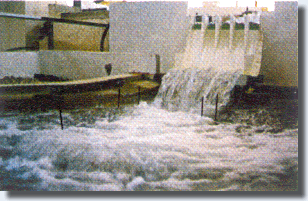Main research areas
Environmental hydraulics (experimental and computational)

- Numerical models of circulation, contaminant dispersion and quality of surface and coastal waters; development and implementation of models for lakes, reservoirs, harbors and gulfs.
- Near field mixing in surface waters: Turbulent buoyant jets and plumes, subject to different geometrical and environmental parameters, dense jets, jet interactions, outfall design.
- Stratified flows; density currents; mixing at density interfaces.
- Modeling of water and wastewater treatment units: Development and application of models for the optimum hydraulic design and operation of treatment units, such as settling tanks.
- Modeling of oil slicks in the sea.
- Marine dredging.
- Mathematical modeling of air quality in enclosed spaces.
Open channel flow and hydraulic structures
- Flow in channel transitions, compound channel sections, drops, weirs and sluice gates, hydraulic jump; channels with large roughness elements, vegetated channels; dam break flows.
- Hydraulic modeling for the optimal design and operation of hydraulic structures such as dam spillways stilling basins, junctions, etc.
Groundwater hydraulics
- Modeling of groundwater flow and pollution in aquifers.
- Soil-water interactions.
- Contaminated soil remediation.
- Hazardous waste management.



